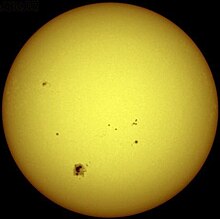San
San istap sta bilong yumi. I gat etpela planet i go nabaut em.

| |
| Observation data | |
|---|---|
| Mean distance from Earth |
1.496 × 1011 m 8.31 min at light speed |
| Visual brightness (V) | −26.74m [1] |
| Absolute magnitude | 4.83m [1] |
| Spectral classification | G2V |
| Metallicity | Z = 0.0177[2] |
| Angular size | 31.6′ - 32.7′ [3] |
| Adjectives | solar |
| Orbital characteristics | |
| Mean distance from Milky Way core |
~2.5 × 1020 m 26 000 light-years |
| Galactic period | (2.25–2.50) × 108 a |
| Velocity | ~2.20 × 105 m/s (orbit around the center of the Galaxy) ~2 × 104 m/s (relative to average velocity of other stars in stellar neighborhood) |
| Physical characteristics | |
| Mean diameter | 1.392 × 109 m [1] 109 Earths |
| Equatorial radius | 6.955 × 108 m [4] 109 × Earth[4] |
| Equatorial circumference | 4.379 × 109 m [4] 109 × Earth[4] |
| Flattening | 9 × 10−6 |
| Surface area | 6.0877 × 1018 m² [4] 11 990 × Earth[4] |
| Volume | 1.412 × 1027 m³ [4] 1 300 000 Earths |
| Mass | 1.9891 × 1030 kg[1] 332 946 Earths[4] |
| Average density | 1.408 × 103 kg/m³[4][1][5] |
| Different Densities | Core: 1.5 × 105 kg/m³ lower Photosphere: 2 × 10-4 kg/m³ lower Cromosphere: 5 × 10-6 kg/m³ Avg. Corona: 10 × 10-12kg/m³[6] |
| Equatorial surface gravity | 274.0 m/s2 [1] 27.94 g 28 × Earth surface gravity[4] |
| Escape velocity (from the surface) |
617.7 km/s [4] 55 × Earth[4] |
| Temperature of surface (effective) |
5 778 K [1] |
| Temperature of corona |
~5 × 106 K |
| Temperature of core |
~15.7 × 106 K [1] |
| Luminosity (Lsol) | 3.846 × 1026 W [1] ~3.75 × 1028 lm ~98 lm/W efficacy |
| Mean Intensity (Isol) | 2.009 × 107 W m-2 sr-1 |
| Rotation characteristics | |
| Obliquity | 7.25° [1] (to the ecliptic) 67.23° (to the galactic plane) |
| Right ascension of North pole[7] |
286.13° 19 h 4 min 30 s |
| Declination of North pole |
+63.87° 63°52' North |
| Sidereal Rotation period (at 16° latitude) |
25.38 days [1] 25 d 9 h 7 min 13 s[7] |
| (at equator) | 25.05 days [1] |
| (at poles) | 34.3 days [1] |
| Rotation velocity (at equator) |
7.189 × 103 km/h[4] |
| Photospheric composition (by mass) | |
| Hydrogen | 73.46 %[8] |
| Helium | 24.85 % |
| Oxygen | 0.77 % |
| Carbon | 0.29 % |
| Iron | 0.16 % |
| Sulfur | 0.12 % |
| Neon | 0.12 % |
| Nitrogen | 0.09 % |
| Silicon | 0.07 % |
| Magnesium | 0.05 % |
Ol referens senisim
- ↑ 1.00 1.01 1.02 1.03 1.04 1.05 1.06 1.07 1.08 1.09 1.10 1.11 1.12 NASA "Sun Fact Sheet"
- ↑ Montalban, Miglio, Noels, Grevesse, DiMauro. Solar model with CNO revised abundances. Retrieved on November 30, 2007.
- ↑ National Aeronautics and Space Administration. Eclipse 99 - Frequently Asked Questions. Retrieved on October 16, 2007.
- ↑ 4.00 4.01 4.02 4.03 4.04 4.05 4.06 4.07 4.08 4.09 4.10 4.11 4.12 Solar System Exploration: Planets: Sun: Facts & Figures. NASA. Archived from the original on 2008-01-02.
- ↑ The Physics Factbook™ Edited by Glenn Elert -- Written by his students.
- ↑ University of Michigan, Astronomy Department.
- ↑ 7.0 7.1 Seidelmann, P. K.; V. K. Abalakin; M. Bursa; M. E. Davies; C. de Bergh; J. H. Lieske; J. Oberst; J. L. Simon; E. M. Standish; P. Stooke; P. C. Thomas (2000). Report Of The IAU/IAG Working Group On Cartographic Coordinates And Rotational Elements Of The Planets And Satellites: 2000. Retrieved on 2006-03-22.
- ↑ The Sun's Vital Statistics. Stanford Solar Center. Retrieved on 2008-07-29., citing
Eddy, John (1979). A New Sun: The Solar Results From Skylab. Washington, D.C: NASA SP-402. pp. 37. http://solar-center.stanford.edu/vitalstats.html.
(Dispela pes San em i liklik tumas. Yu inap raitim moa sapos yu laik halivim Wikipedia. Hau?)